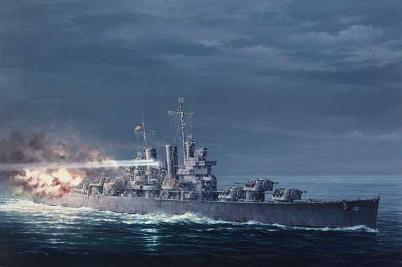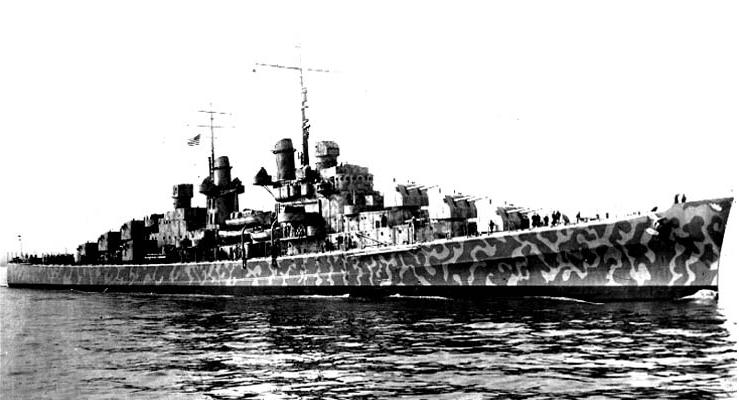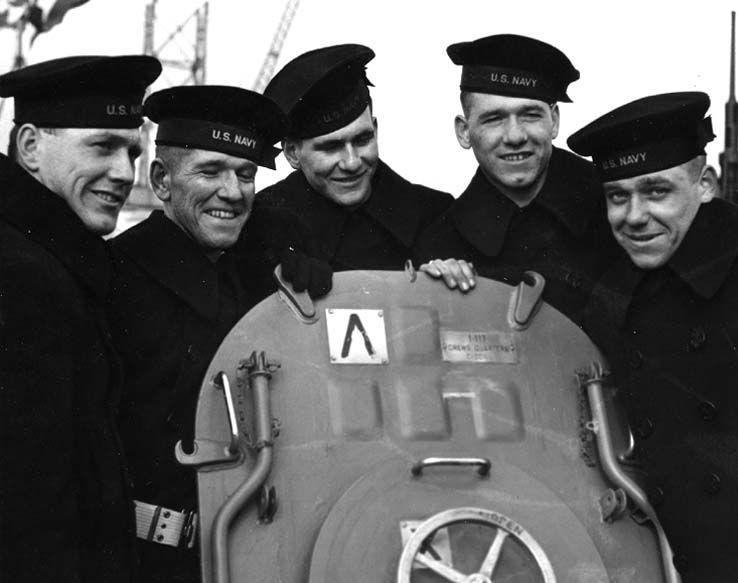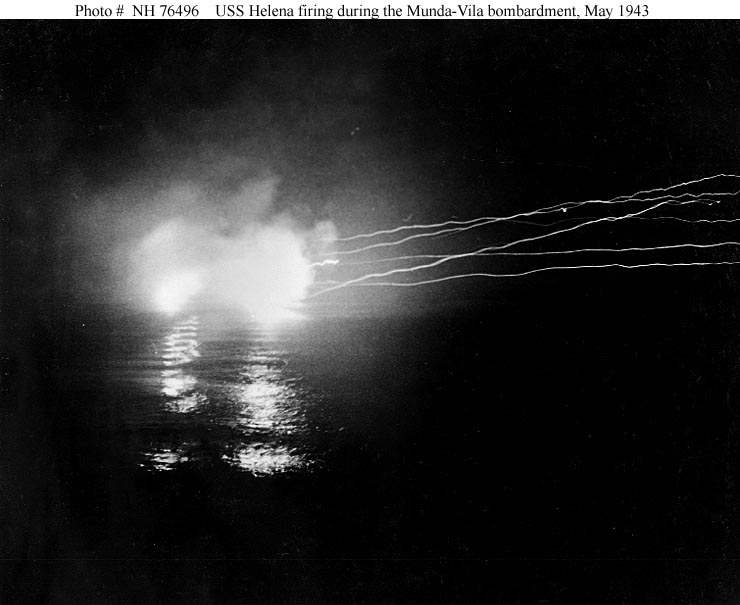We left California in early August 1942, with Captain Oliver M. Read in command of the ship escorting a converted aircraft carrier, some supply ships which were carrying food and ammunition for the Marines on Guadalcanal, and a few destroyers. The Marines had landed on Guadalcanal and captured Henderson Field. This battle for Guadalcanal was America's first offensive action in the Pacific. For the next four months, the Japanese would throw everything they had at us to take back Guadalcanal. However, we were just as determined to keep the island. A few days before we reached Guadalcanal, we heard about a night sea battle in which four cruisers, one Australian and three American, the Vincennes, Quincy, and the Astoria, all heavy cruisers had been sunk without a single loss to the Japanese. It was a total defeat for our side. The difference between heavy and light cruisers is the heavy cruisers have 8-inch guns, while the light cruisers have 6-inch guns. The bad news was very disheartening to us. In August of 1942, we were greatly outnumbered by the Japanese Navy. Also the Japanese had more experience with night tactics, and their torpedoes were superior to ours. However we had the edge with radar, a big advantage. We also learned from our early mistakes and improved our night tactics to the point that we would ultimately beat the Japanese at their own game. But we would pay a terrible price with the loss of good men, ships and planes.
The food on the ship wasn't bad, you got used to it. They had names for it, but I wouldn't want to put it in print. For a period of three weeks no ship was getting through. Everything was going to Europe, England and Russia so no supplies ships were getting out to the Pacific. We ate beans for three weeks, all different kinds of beans, whatever was in the cans. Or whatever was in the freezer we ate, but beans mostly.
So many ships were sunk off the northern coast of Guadalcanal, both ours and theirs, that the area was nicknamed "Iron Bottom Sound." There were many nights when the Japanese warships, often referred to as "The Tokyo Express," came down the Slot to try to land additional troops and to bombard our Marines. The Slot was a waterway which extended roughly from the Japanese held Bougainville and Rabaul southeast to Guadalcanal. The U.S. Navy's job was to meet the Tokyo Express and try to destroy the enemy no matter what the odds.
The Helena made 2 quick trips to Guadalcanal escorting ships transporting Marines to Guadalcanal and we operated with Task Force #7 which included the carrier Wasp. On the afternoon of September 15, 1942 the carrier Wasp was suddenly hit by 3 Japanese submarine torpedoes. Almost at once she became a blazing inferno. I was on deck and witnessed the whole thing. The crew battled fires as long as possible, but it was a losing effort. The carrier was rocked by several massive explosions and had to be abandoned. Two other torpedoes missed the Wasp, and passed just off our stern. We kept circling the Wasp, along with some destroyers. Our ship picked up about 400 officers and men and took them to Espiritu Santo. The Wasp had to be sunk by our own destroyers; it was too far gone to be saved. This was a hard blow to all of our spirits. We never saw the submarine that fired the torpedoes, so we didn't fire a shot. Also, I was promoted to Chief Petty Officer.
Battle of Cape Esperance

The Battle of Cape Esperance . 11/12 October 1942
by
Marii Chernev
Used with permission. The Military Art Gallery
Ed Kaminski, Gallery Director
At 2346 Hrs on the night of 11 Oct 1942, the USS Helena, which was part of Rear-Admiral Norman Scott's Task Force 64, opens fire on the IJN Destroyer Hatsuyuki.
The resulting battle with the Japanese Fleet off the critical island of Guadalcanal led to the sinking of two Japanese ships and the damage to three others.
U.S. Navy casualties consisted of the Destroyer USS Duncan.
To view the Military Art Gallery web page click on the "The Battle of Cape Esperance" picture.
The Helena became part of Task Force 64, along with the cruisers San Francisco, Boise, and Salt Lake City, as well as 5 destroyers. The San Francisco was the flagship of the task force, commanded by Admiral Scott. The task force provided cover for the landing of troops and supplies on Guadalcanal.
The Japanese were determined to reinforce its troops on Guadalcanal. Air attacks from Guadalcanal had slowed down the “Tokyo Express” for several days. On October 11, 1942, the Japanese poured everything they could against Henderson Field, hoping to neutralize the airstrip long enough to bring in troop reinforcements during the night. Task Force 64 was sent to stop them. The Japanese fleet closed and by 1810 (that’s 6:10 pm) was only 100 miles from Savo Island. The Helena had the best radar system and we opened fire on the enemy at 23:46 (that’s 11:46 at night). I was on the main throttle in the after engine room, I had the 8 to 12 mid watch. The first few salvos with the main guns covered us with loads of dust that had accumulated in the blower system, but every salvo was a most satisfying feeling because we were getting even for the treachery at Pearl Harbor. We fired many minutes and we got credit for sinking the cruiser Furutaka and the destroyer Fubuki, and assisting with the sinking of two other ships. All this took place within a few minutes. Our task force ended up sinking four enemy cruisers and four destroyers. The Boise and two of our destroyers were heavily damaged, but none of our ships were sunk. The battle was a badly needed lift for our morale and at last we got some sweet revenge.
I learned the next day that we had actually opened fire without permission from Admiral Scott. Our radar had picked up the enemy ships, and we radioed the San Francisco for permission to open fire. The reply was “What are you going to shoot at?” Ten minutes later, we asked again. The San Francisco replied with “Roger”, meaning that they had received our request, but our bridge crew misinterpreted it as meaning we had permission to open fire. So our guns opened up, and the flagship had no idea what we were firing at. Their radar hadn’t picked up the Japanese fleet yet. The Boise had similar radar to the Helena, so as soon as we opened fire, they joined in. With two other ships firing, the San Francisco joined in as well, which really surprised Admiral Scott. That was one of the problems this early in the war; our commanders did not trust the new radar technology.
Helena was next under attack on the night of October 20th near San Cristobal. We were on a routine patrol with a small force that included the heavy cruiser Chester. We came under torpedo attack from a Japanese submarine. Several torpedoes exploded near us but none hit us. Our captain was Captain Hoover, an ex-destroyer captain, really knew how to handle a ship and he was able to dodge all the torpedoes meant for us. The Chester was not as fortunate, and was struck by one torpedo. The Chester was damaged, but able to maneuver away under her own power. As with the sinking of the Wasp, we could not locate the enemy submarine, so we didn’t fire a shot.
Naval Battle of Guadalcanal
The Helena was assigned to Task Force 67. Again, the San Francisco was the flagship, this time under the command of Admiral Callaghan. Admiral Scott was in a support position aboard the light cruiser USS Atlanta. The other ships in the task force were the heavy cruiser Portland and the light cruiser Juneau, along with eight destroyers.
We were assigned to escort some supply ships from Espiritu Santo to Guadalcanal. We made contact with the convoy on November 11th and brought it safely into Guadalcanal. During the afternoon of November 12, 1942, word came from a coast watcher that “enemy aircraft approaching.” Unloading of the supply ships ceased and the supply ships pulled away from shore and formed a large circle, just like “circling the wagons” in the Western films. There were 28 “Betty’s,” 2 motor bombers, coming in to attack us. Our own aircraft from Henderson Field broke up the first attack and superb maneuvering of the fleet helped us all to shoot down 8 enemy Mitsubishi planes. However, the second attack damaged 2 ships. A two motor bomber crashed into the after turret of the cruiser San Francisco, putting the turret and 3 – 8” guns out of action. Our fighter planes form Henderson Field got most of the left over bombers. We called this a great victory and no supply ships were lost. The Helena came through the action without a scratch. This was only the beginning of the 3 day battle. Our patrol planes sighted a large group of Japanese ships heading toward Guadalcanal and they were all fighting ships, no transports. The Japanese force was estimated at over 20 warships including 2 battleships. All we had was 3 light cruisers, 8 destroyers, and 2 heavy cruisers, 13 ships in all, and the San Francisco had a damaged turret out of action for the night battle which ensued.
We got a lot of information from the coast watchers. They were from New Zealand and Australia. They would hide way up high and could see any Japanese movements out of Truk. Truk was the main base of the Japanese fleet, about 500 miles north of us. They would report so we knew exactly what to expect.
Our transports quit unloading supplies and troops and headed away from Guadalcanal. Then, the Helena resumed patrol near Guadalcanal. The Helena, with its superior radar, was again the first ship to pick up the enemy ships which were approaching in two columns around Salvo Island. Our task force went up the middle, which was to our advantage because our ships could fire from both sides. The battle was fierce and lasted about 30 minutes. From reports we got over the J.V. phones, the San Francisco was taking a beating from the Japanese battleship. The J.V. phones are sound-powered phones used for communication between key stations on the ship, and do not require any power source, not even batteries. I was stationed on a repair station above the after engine room. We were given candy bars before we engaged the enemy to give us extra energy. Also, during the battle, there was one humorous incident, although it wasn’t so funny for the sailor we were watching. This signalman came down from the bridge accompanied by a hospital corpsman. He had taken a shrapnel hit on his back side and because no light could be shown on topside, they came down below where we were, and the hospital corpsman was picking pieces of shrapnel out of his butt. I felt sorry for the wounded sailor, but we couldn’t keep from smiling. Reports kept coming in over our phones from the bridge, the San Francisco was steaming out of control so we sent them a signal to follow us out of the “slot” as we called it. The Atlanta and Portland were out of action. The Juneau took a torpedo. Quite a few of our 8 destroyers were lost in the battle. The short battle had taken a heavy toll, but the enemy called off the battle and withdrew, heading north. The Helena had sunk or helped sink five enemy ships.
As daylight drew near, we took stock of what had survived the night battle. The Helena had received hits on the superstructure and one of the turrets, but was still in fighting condition. The cruiser Juneau was down at the bow from the torpedo hit, but was able to make about 15 knots. The cruiser San Francisco had lost its Admiral, Captain, and executive officer on the bridge. Only the navigator, Lt Cmdr McCandless survived to take charge of the ship, which would need to head back to Pearl Harbor for repairs. There were only 5 of us left out of 13 ships that could maneuver under their own power. The remaining ships sunk or were too damaged to maneuver. The Portland and a destroyer were later assisted back to Espiritu Santo. The Atlanta was too damaged to be repaired, so her crew was evacuated and the ship blown up. Admiral Scott had been killed during the battle, leaving our Captain Hoover in command of the task force. The destroyers had a lot of damage from charging into the battleships.
As bad as the damage to our fleet was, it could have been worse. The Japanese ships were using bombardment ammunition because they had intended on bombarding our positions on the island. It’s different from the armor-piercing solid shells because it breaks up into a lot of shrapnel when it explodes. They clearly were not anticipating us to be there, and had planned a major bombardment against our Marines.
As light dawned, our planes from Henderson Field on Guadalcanal bombed a Japanese battleship that was damaged during the night battle and sank it with large bombs. Also some troop transports that tried to land thousands of troops on Guadalcanal were sunk by our planes.
Our five ships, the Juneau behind us, were heading south to our home port of Espiritu Santo. About mid-morning I was up on the quarter-deck getting some air and sun and looking toward the Juneau when there was a big explosion. When the smoke had cleared the cruiser Juneau had disappeared. Large pieces of the ship were hurtling through the air and I dived under the nearest turret for safety. We had run into a nest of Japanese submarines and the Juneau got another fish torpedo in her ammunition magazine. The ship just blew apart into pieces and sank in a few seconds. Almost all hands were lost, only a few survived to tell the story. Of the seven hundred men on the Juneau, only one hundred made it off the ship.

USS Juneau CL-52
No effort was made to pick up survivors because our small and damaged force was just as vulnerable to the lurking submarines. Our Captain Hoover had dodged the torpedoes that were meant for us. A message from our ship was relayed to a U.S. B-17 bomber in the area to notify Admiral Halsey’s headquarters where rescue efforts could be initiated. Tragically the message never got through and only ten of the hundred men in the water survived the eight-day ordeal. When the Juneau blew up, it took the five Sullivan brothers to their watery grave. All five brothers wanted to be on the same ship, and the Navy had granted their request.

The Sullivan Brothers
So we got back to Espiritu Santo with only 4 ships out of 13.
Aboard ship, we were lucky enough to have a band. We had two black men on board, one of them loved to dance and show off. When that band started playing, boy, when he smiled he showed them big teeth and everybody else would start laughing. The San Francisco was so shot up the morning after the battle we sent our band over to the San Francisco to cheer them up.
The Helena was sent to Sydney, Australia for repairs. One of our rear gun turrets had taken a direct hit during the battle and the center gun stuck in when it was fired. Also a lot of holes in the upper superstructure had to be patched up. As we were pulling up to a dock in Sydney, the people on the dock asked, “What happened to your ship?” and our sailors answered “Termites.” We all got a good laugh out of that remark.
We stayed in Sydney for 20 days getting patched up. We got off ship every other night. We also got fresh milk which we hadn’t seen for months, but it was scarce and expensive. There were plenty of good steaks in the restaurants. Whiskey was also cheap and could be bought at a government liquor store. We hated to go back into the warzone, but there was no choice. On the way back we got the bad news. “Your ship is expendable.” We thought we were going back to states when they said that. But that was not what happened. Our Navy didn’t have many fighting ships left to guard our field on Guadalcanal. So that lowered our spirits about 90%.
While we were in Sydney, Captain Hoover was replaced by Captain Charles P. Cecil. The word was that Captain Hoover was relieved of command because he did not attempt to rescue the survivors of the Juneau. At the time, I thought Captain Hoover did the right thing to not risk losing additional ships, and I still feel that way.
During January of 1943 we bombarded Japanese positions on New Georgia, Munda, and Vila Stanmore. We were also attacked on several occasions by Japanese aircraft. We were able to repel those attacks with our antiaircraft guns, and some help from the planes from Henderson Field.
On one of the moonlit nights that we bombarded New Georgia, Rice Anchorage, our old destroyers, some of which had been converted to mine layers, laid a group of mines across the entrance to the harbor. They left enough room for us to get out after we blasted the Japanese positions. Then one of our submarines watched as the Japanese troop ships and supply ships came into the entrance of the harbor. They ran into the mines and a few were sunk.
During the battles we usually had 2 firemen with J.V. phones on their ears, and they repeated any messages to the chief engineer on watch that came from the captain’s bridge. The captain said “elevate those guns a bit and get those sons of bitches that ran up the hill.” This gave us a laugh in the after engine room. The missions to convoy troops and bombard shore position continued until July 1943.


